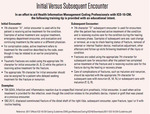7th Characters Certain ICD-10-CM categories have applicable 7th characters. The applicable 7th character is required for all codes within the category, or as the notes in the Tabular List instruct. The 7th character must always be the 7th character in the data field. If a code that requires a 7th character is not 6 characters, a placeholder X must be used to fill in the empty characters.
Categories for traumatic fractures have additional 7th character values, so don’t slap an A, D, or S on the end of a fracture code and assume you’ve got it right.
As an example, S72.- Fracture of femur has these 7th character options:

 www.aapc.com
www.aapc.com
Coding of Traumatic Fractures
Initial vs. subsequent encounters for fractures
Traumatic fractures are coded using the appropriate seventh characters for initial encounter (A, B, C) while the patient is receiving active treatment for the fracture. Examples of active treatment include surgical treatment, emergency department encounters and evaluation and/or treatment by a new physician. The appropriate seventh character for initial encounter also should be assigned for a patient who delayed seeking treatment for a fracture or nonunion.
Subsequent treatment of fractures are coded using the appropriate seventh character indicating subsequent care for encounters occurring after the patient has completed active treatment of the fracture (D-R).
 www.icd10monitor.com
www.icd10monitor.com

Coding of Traumatic Fractures
The principles of multiple coding of injuries should be followed in coding
fractures. Fractures of specified sites are coded individually by site in
accordance with both the provisions within categories S02, S12, S22, S32, S42,
S49, S52, S59, S62, S72, S79, S82, S89, S92 and the level of detail furnished by
medical record content.
A fracture not indicated as open or closed should be coded to closed. A fracture
not indicated whether displaced or not displaced should be coded to displaced.
More specific guidelines are as follows:
1) Initial vs. subsequent encounter for fractures
Traumatic fractures are coded using the appropriate 7th character for
initial encounter (A, B, C) for each encounter where the patient is
receiving active treatment for the fracture. The appropriate 7th character
for initial encounter should also be assigned for a patient who delayed
seeking treatment for the fracture or nonunion.
Fractures are coded using the appropriate 7th character for subsequent
care for encounters after the patient has completed active treatment of the
fracture and is receiving routine care for the fracture during the healing
or recovery phase.
Care for complications of surgical treatment for fracture repairs during
the healing or recovery phase should be coded with the appropriate
complication codes.
Care of complications of fractures, such as malunion and nonunion,
should be reported with the appropriate 7th character for subsequent care
with nonunion (K, M, N,) or subsequent care with malunion (P, Q, R).
Malunion/nonunion: The appropriate 7th character for initial encounter
should also be assigned for a patient who delayed seeking treatment for
the fracture or nonunion.
The open fracture designations in the assignment of the 7th character for
fractures of the forearm, femur and lower leg, including ankle are based
on the Gustilo open fracture classification. When the Gustilo
classification type is not specified for an open fracture, the 7th character
for open fracture type I or II should be assigned (B, E, H, M, Q).
A code from category M80, not a traumatic fracture code, should be used
for any patient with known osteoporosis who suffers a fracture, even if
the patient had a minor fall or trauma, if that fall or trauma would not
usually break a normal, healthy bone.
See Section I.C.13. Osteoporosis.
The aftercare Z codes should not be used for aftercare for traumatic
fractures. For aftercare of a traumatic fracture, assign the acute fracture
code with the appropriate 7th character.
Multiple fractures sequencing
Multiple fractures are sequenced in accordance with the severity of the
fracture.
3) Physeal fractures
For physeal fractures, assign only the code identifying the type of
physeal fracture. Do not assign a separate code to identify the specific
bone that is fractured.
- A – Initial encounter
- Surgical treatment
- Emergency department encounter
- Evaluation and treatment by a new physician
- D – Subsequent encounter
- Healing or recovery phase
- Cast change or removal
- Removal of external or internal fixation device
- Other after-care and follow-up visits following treatment of an injury or condition
- S – Sequela encounter
- Complications or conditions that arise as a direct result of a condition
- An example, again, would be scar formation after a burn. The scars are sequela of the burn.
- Complications or conditions that arise as a direct result of a condition
Categories for traumatic fractures have additional 7th character values, so don’t slap an A, D, or S on the end of a fracture code and assume you’ve got it right.
As an example, S72.- Fracture of femur has these 7th character options:
- A, initial encounter for closed fracture
- B, initial encounter for open fracture type I or II
- C, initial encounter for open fracture type IIIA, IIIB, or IIIC
- D, subsequent encounter for closed fracture with routine healing
- E, subsequent encounter for open fracture type I or II with routine healing
- F, subsequent encounter for open fracture type IIIA, IIIB, or IIIC with routine healing
- G, subsequent encounter for closed fracture with delayed healing
- H, subsequent encounter for open fracture type I or II with delayed healing
- J, subsequent encounter for open fracture type IIIA, IIIB, or IIIC with delayed healing
- K, subsequent encounter for closed fracture with nonunion
- M, subsequent encounter for open fracture type I or II with nonunion
- N, subsequent encounter for open fracture type IIIA, IIIB, or IIIC with nonunion
- P, subsequent encounter for closed fracture with malunion
- Q, subsequent encounter for open fracture type I or II with malunion
- R, subsequent encounter for open fracture type IIIA, IIIB, or IIIC with malunion
- S, sequela

7 Top Tips for Mastering ICD-10-CM 7th Characters
Diagnosis coding brings the unique challenge of knowing when to use a 7th character on your ICD-10-CM code and then determining which character applies.
Coding of Traumatic Fractures
- The principles of multiple coding of injuries should be followed while coding fractures. Fractures of specified sites are coded individually, by site, in accordance with both the provisions within categories S02, S12, S22, S32, S42, S49, S52, S59, S62, S72, S79, S82, S89 and S92, and the level of detail furnished by medical record content.
- A fracture not indicated as open or closed should be coded as closed. A fracture not indicated as displaced or non-displaced should be coded as displaced.
Initial vs. subsequent encounters for fractures
Traumatic fractures are coded using the appropriate seventh characters for initial encounter (A, B, C) while the patient is receiving active treatment for the fracture. Examples of active treatment include surgical treatment, emergency department encounters and evaluation and/or treatment by a new physician. The appropriate seventh character for initial encounter also should be assigned for a patient who delayed seeking treatment for a fracture or nonunion.
Subsequent treatment of fractures are coded using the appropriate seventh character indicating subsequent care for encounters occurring after the patient has completed active treatment of the fracture (D-R).
- D, E, F – Subsequent treatment with routine healing
- G, H, J – Subsequent treatment with delayed healing
- K, M, N – Subsequent treatment with nonunion
- P, Q, R – Subsequent treatment with malunion
Seventh Character Code Categories and ICD-10-CM
Physicians and hospital administrators realize that optimizing workflows to accommodate urgent care and emergent services will require additional data

Coding of Traumatic Fractures
The principles of multiple coding of injuries should be followed in coding
fractures. Fractures of specified sites are coded individually by site in
accordance with both the provisions within categories S02, S12, S22, S32, S42,
S49, S52, S59, S62, S72, S79, S82, S89, S92 and the level of detail furnished by
medical record content.
A fracture not indicated as open or closed should be coded to closed. A fracture
not indicated whether displaced or not displaced should be coded to displaced.
More specific guidelines are as follows:
1) Initial vs. subsequent encounter for fractures
Traumatic fractures are coded using the appropriate 7th character for
initial encounter (A, B, C) for each encounter where the patient is
receiving active treatment for the fracture. The appropriate 7th character
for initial encounter should also be assigned for a patient who delayed
seeking treatment for the fracture or nonunion.
Fractures are coded using the appropriate 7th character for subsequent
care for encounters after the patient has completed active treatment of the
fracture and is receiving routine care for the fracture during the healing
or recovery phase.
Care for complications of surgical treatment for fracture repairs during
the healing or recovery phase should be coded with the appropriate
complication codes.
Care of complications of fractures, such as malunion and nonunion,
should be reported with the appropriate 7th character for subsequent care
with nonunion (K, M, N,) or subsequent care with malunion (P, Q, R).
Malunion/nonunion: The appropriate 7th character for initial encounter
should also be assigned for a patient who delayed seeking treatment for
the fracture or nonunion.
The open fracture designations in the assignment of the 7th character for
fractures of the forearm, femur and lower leg, including ankle are based
on the Gustilo open fracture classification. When the Gustilo
classification type is not specified for an open fracture, the 7th character
for open fracture type I or II should be assigned (B, E, H, M, Q).
A code from category M80, not a traumatic fracture code, should be used
for any patient with known osteoporosis who suffers a fracture, even if
the patient had a minor fall or trauma, if that fall or trauma would not
usually break a normal, healthy bone.
See Section I.C.13. Osteoporosis.
The aftercare Z codes should not be used for aftercare for traumatic
fractures. For aftercare of a traumatic fracture, assign the acute fracture
code with the appropriate 7th character.
Multiple fractures sequencing
Multiple fractures are sequenced in accordance with the severity of the
fracture.
3) Physeal fractures
For physeal fractures, assign only the code identifying the type of
physeal fracture. Do not assign a separate code to identify the specific
bone that is fractured.


